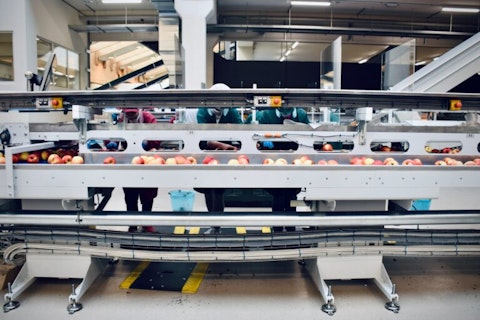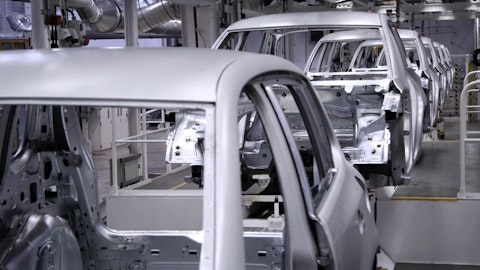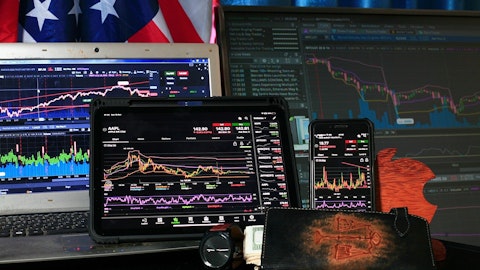In this article, we will take a detailed look at the 12 Most Automated Industries in the US, with insights into the automation industry and trends. For a quick overview of the top 5 automated industries, read our article 5 Most Automated Industries in the US.
Industrial robots were invented 50 years ago. The learning curve of human nature is complex. Hence, it took many years to understand and implement automation in industries at massive levels for lucrative output. The US automation industry is expected to grow at a CAGR of 16.4% from 2022 to 2027. Moreover, it’s projected that AI could increase US labor productivity by 0.5 to 0.9 percentage points by 2030.
Artificial intelligence (AI)-driven automation is swiftly revolutionizing businesses across various sectors. In 2021, the automation market size was valued at $177.75 billion and is expected to reach $441.7 billion by 2023. Unlike manual workers, robots are faster, more robust, and can work tirelessly 24/7. This reflects the time freed up by automation for humans. For example, implementing AI-powered automation can seamlessly handle repetitive tasks like customer service chatbots and data entry. This, in turn, allows employees to focus on more creative and strategic work.
AI can also create new opportunities for businesses to improve productivity, efficiency, and customer service. For instance, AI can improve decision-making through machine learning techniques that dissect data and discern patterns. This proves invaluable in aiding businesses to make well-informed pricing, marketing, and product innovation choices.
Congress is planning to increase the amount of money spent on AI research and development (R&D). They want to double the funding each year until it reaches $32 billion by 2026. The Biden Administration is also suggesting a bigger budget for R&D in 2023, with a total of more than $204 billion. This is a 28% increase from what was approved in 2021. Some of this money will go towards supporting new and existing research institutes focused on artificial intelligence and automation. These institutes bring together government agencies, private companies, nonprofits, and schools to work on AI projects.
Automation is the need of every lucrative industry. Its trans-mutative power is taking industries to unprecedented success and efficiency by saving time and revolutionizing operations. By utilizing cutting-edge technologies like ML, AI, IoT, and Digital Twins, automation controls machinery to increase performance by speeding up the processes in miscellaneous industries. This decreases the need for human labor, minimizes waste, and saves material costing and electricity. In this fast-paced business world, industries are adopting automation quickly to improve safety, quality, labor cost, and productivity.
However, this has also led to the narrative that AI will result in job loss for humans. But contrary to this popular opinion, industrial automation is expected to create more jobs in the future. Data shows that by 2030, the manufacturing industry will have 2.1 million unfilled jobs. The USA is forecasted to face a shortage of 400,000 welders by 2024. It shows that AI is not a threat to human jobs, rather it’s a data-driven approach to improving production and a technological way to fill the job and skills gap.
For humans, having problem-solving skills without motivation is not enough to cater to the challenges of the fast-paced digital world. This problem can be resolved using AI. For instance, robots don’t need any motivation to utilize their problem-solving skills for any challenge. They are programmed to solve the problem, regardless of its level of complexity.
A Look into the Automation Industry
Automation companies are gaining a lot of attention from investors in the automation companies’ stock market, thanks to the huge effects of automation on different industries. Companies like Rockwell Automation (NYSE:ROK) and ABB Group (SWX:ABBN) have stood out as top automation companies in the USA. Such companies provide various automation solutions for industrial and commercial customers, including control systems, software, and industrial automation products.
Rockwell Automation (NYS:ROK) demonstrated great performance over the past year, with its stock price increasing by approximately 25%. The company is also committed to sustainability and is working to develop automation solutions that reduce the environmental impact of manufacturing. The global automation market is expected to grow by 6% annually through 2025, and Rockwell Automation (NYSE:ROK) is well-positioned to capture a share of this growth.
Similarly, ABB Group (SWX:ABBN), a global leader in robotics, automation, and electrification, displayed a stock price growth of around 18% over the past year. This reflects the inherent potential within the automation sector and the growing investor confidence in companies spearheading technological advancements. Being a Swiss multinational corporation, ABB (SWX:ABBN) stock has risen by over 15% in the past year and is currently trading at $28 per share. As automation continues to reshape industries, monitoring these key players’ stock performance remains paramount to stakeholders seeking to capitalize on this evolving landscape.
Industries are embracing automation as a strategic tool to gain a competitive edge, fuel economic growth, and lead global innovation. From manufacturing to healthcare, logistics to finance, automation has reshaped industries, enabling them to stay competitive in the fast-paced digital era. These industries have embraced automation to propel themselves to the forefront of global innovation.

Photo by Arno Senoner on Unsplash
Methodology
We used four key metrics to rank the most automated industries in the US: Robot Density, Industrial Robot Installations, Automation Investment, and Process Cycle Time.
We have collected the latest Robot Density and Automation Investment data from IFR to ensure that our rankings are current and valid. The data for industrial robot installations has been taken from the RIA and Robotics Business Review. To ensure that our rankings are latest and up to the minute, the data is collected for 2021 and 2022. We collected data for the automated industries globally and then ranked them specifically for the USA, acknowledging its eminent stature as a global frontrunner.
We started by scoring industries on each index from 1 to 12 (12 being highly automated and 1 being the least automated in our study). We then calculated the weighted averages for defined metrics to bring clarity and accuracy to our ranking. The metrics have been assigned weights as below:
- Robot Density: 0.3
- Industrial Robot Installations: 0.3
- Automation Investment: 0.3
- Process Cycle Time: 0.1
After calculating weighted averages, a scoring system was used to rank the most automated industries in the US on a scale of 12 (least automated on our list) to 1 (most automated on our list).
Let’s take a look at the 12 most automated industries in the US.
Most Automated Industries in the US
12. Oil and Gas Refining Industry
The global oil and gas refining automation market is expected to reach $4.74 billion by 2025. Automation in the Oil and Gas Refining Industry plays a crucial role at various stages of production and delivery. The safety of human labor is of paramount concern during the operations, controlling, and cleaning processes. Routine risks can be minimized by automating tasks like cleaning tanks, handling toxic chemicals, checking and balancing over-pressure, flow, and maintenance.
By leveraging automation in the refining industry, benefits like optimizing operations, more productivity, and safer and more sustainable working environments can be enjoyed.
11. Waste Management and Recycling Industry
Automation is significant in streamlining the waste collection and sorting phases. Automated machinery with sensors and robotic arms can quickly collect waste material. The programmed optical scanners and machine learning (ML) algorithms enhance efficiency by quickly sorting the material from mixed waste streams and reducing the process cycle time.
Automated technologies can also detect the level of waste in bins and dumpsters. This will decrease manual exertions, hence minimizing the risk of injuries. IoT devices are used to monitor the waste material volume and other parameters. This helps waste management companies collect and analyze the data, identify patterns and trends, and optimize recycling efforts.
10. Food and Beverages Industry
By ensuring the minimum possible error in packaging and labeling, automation plays a significant role in the food and beverages industry. It helps with accurate and proportionate sealing, portioning, and labeling. Real-time inspections can be done using sensors and cameras to detect foreign objects, defects, and inconsistencies within the packed material.
The industry-specific tasks like weighing and mixing ingredients, frying, baking, and cooking can be performed uniformly using robotic arms and conveyor belts. In the inventory management phase, automated systems can help track orders, stock levels, and expiration date monitoring. Automation also plays a vital role in picking, packing, shipping, and delivering orders. This improves efficiency, reduces processing time, and increases customer satisfaction.
9. Aerospace Industry
In the aerospace industry, tasks like material placement, aircraft component fabrication, and assembly line operations can be performed using automated systems. This reduces errors, ensures consistency, and reduces the processing time. The advanced sensors and NDT (Non-Destructive Testing) technologies can efficiently and thoroughly inspect engines, aircraft components, and structures.
A significant contribution of automation systems in the aerospace industry is performing inspections in difficult-to-reach areas using robotic crawlers and drones. Automation’s significant advantages are autopilots and flight management systems with precise navigation and control. Advanced ML algorithms and analytics can reduce the processing time and errors in data collection from aircraft sensors, flight operations, and record maintenance.
8. Warehousing Industry
The global warehouse automation market is expected to reach $41 billion by 2027. In the warehouse industry, the tasks like order picking, sorting, and delivering can be performed speedily with accuracy using the automation technologies like AGVs (Automated Guided Vehicles), robot pickers, and conveyor belts. This results in reduced process time, decreasing the need for manual labor and removing the maximum errors, ultimately leading to enhanced operational efficiency.
Automation technologies can handle other significant tasks in this industry, including tracking inventory, monitoring stock movements, and providing accurate list data. This offers benefits like efficient demand planning, reducing carrying time and cost, and avoiding overstocking or stock-outs. Automated machinery and robots can carry heavy loads and hazardous substances and lower workplace injuries and risks associated with manual labor.
7. Food Processing Industry
The global food automation market is expected to hit $15.1 billion by 2030. The tasks like sorting, cutting, mixing, slicing, and packaging can be done quickly and precisely using automation technologies. This will reduce the need for manual labor, minimize errors, and increase the overall efficiency of the industry.
By minimizing the chances of error, automation systems can also control and monitor the critical parameters of food processing, like pressure, temperature, time, and consistency of the final product, while adhering to food safety regulations. A large number of orders can be processed in less time. Automation can handle large volumes of ingredients for grand finished products to meet the increasing demand in the market. At first, the cost of incorporating automation systems in the food processing industry seems high, but in the long term, it is a cost-saving technique for the long term.
6. Steel and Metal Industry
Automated technologies like CNC machinery, robotic arms, and other automated equipment perform the task quickly, consistently, and precisely. These technologies can carry heavy loads, do processing in high temperatures, and function with hazardous material without any risks. Advanced automated technologies can operate the phases of all processes with advanced safety features, like emergency stops, sensors, and interlocking systems. This leads to a safer working environment for the workers.
The critical factors of the steel and metal industry, like pressure, temperature, material dimensions, material installations, and cutting, can be efficiently operated using automated technologies. Moreover, changeovers at a fast speed and reduced downtime are significant advantages of using automation in the steel and metal industry. Automation technologies can be programmed to follow strict safety standards, leading to long-term safety goals and cost savings.
Click to continue reading and see 5 Most Automated Industries in the US.
Suggested Articles:
- 10 Industries Being Revolutionized By AI and Automation Technologies
- 13 Best Automation Stocks to Buy Now
- Top 15 Automation Companies in the US
Disclosure. None. The 12 Most Automated Industries in the US is originally published on Insider Monkey.





